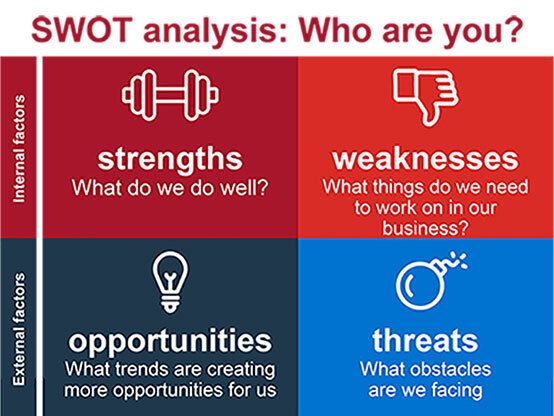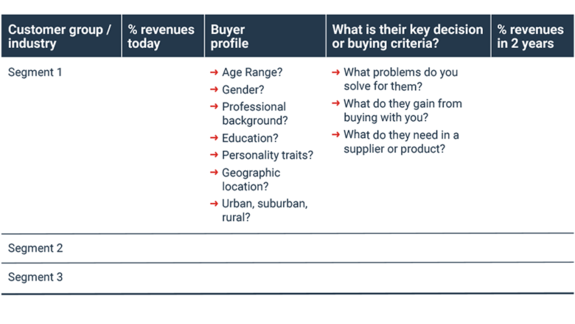How to write a marketing plan
A marketing plan is like a GPS for your business: it shows you the best way to reach your sales and revenue goals while avoiding any time-consuming and costly errors along the way. BDC Senior Business Advisor Mallika Kazim provides some tips for developing a marketing plan that will help map out your route and keep your business on course.
What is a marketing plan?
A marketing plan outlines your intended marketing/advertising activities for a specific period, usually over the next 12 months. It describes how you’ll reach, attract and persuade customers to buy your products or services, with clear goals, actions and accountabilities.
While large corporations might have an overarching marketing strategy with individual plans for each part of the strategy, Kazim recommends entrepreneurs with smaller businesses keep things simple.
“Think in practical terms,” she says. “It’s not about capital-S ‘Strategy’, it’s a how-to for achieving your targets.”
The marketing plan is your attack plan for chasing after your high-priority revenue opportunities.
Mallika Kazim
BDC Senior Business Advisor
What is the purpose of a marketing plan?
Most businesses will have many different plans that interlink and support each other.
Your marketing plan identifies the promotional tactics that will help you accomplish the goals of your business plan, which sets out your target markets and the solutions you’ll offer to them. It should also connect with your strategic plan, which sets the overall direction for your business for the next three to five years.
“If you’ve done your business plan, you know who you want to sell to and why,” says Kazim. “The marketing plan is your attack plan for chasing after your high-priority revenue opportunities.”
A well-built marketing plan also builds confidence with financial institutions, showing lenders your business has a good chance of being successful.
How to build a marketing plan in 5 steps
Creating a marketing plan typically involves the following steps:
1. Conduct a SWOT analysis
Look at your own strengths, weaknesses, opportunities and threats:
- Strengths are factors that improve your position in the marketplace. These can include skills, capabilities and proficiencies that can't easily be copied by your competitors, such as low production costs due to superior technology.
- Weaknesses are factors that reduce your ability to achieve your objectives, such as unreliable delivery or outdated production tools.
- Opportunities are ways your business can grow and become more profitable. These might include entering new markets or adopting new technologies.
- Threats are factors that could have a negative impact on your business in your primary markets, such as labour shortages or detrimental economic/political developments.
Because your strengths and weaknesses are defined in relation to your competitive environment, as part of this step, you’ll also want to conduct a competitive analysis to gain a complete picture of where you stand in the marketplace.

2. Profile your customers
Organize your current customers into three or four main groups—perhaps by industry or transaction size. Then drill down into what defines the customers in those groups: who they are, what they want, how much they buy, the information they use to make purchasing decisions and so on.
Example of a customer segmentation table
This is your opportunity to demonstrate that you know your customers inside and out. Paint a robust picture of them, including characteristics such as age, gender, profession, income level, education and geographic location. It’s also important to understand what motivates them to buy. Ask yourself why they would choose your products—and what might keep them away from your competitors.
“This is often the ‘a-ha’ moment,” says Kazim. “Many entrepreneurs think all their customers are the same, but that’s not true. By refining your customer segments in this way, it makes it possible prioritize and apply your marketing dollars much more effectively.”
3. Set clear objectives
What do you want to achieve with your marketing plan? Make sure those goals are attainable and realistic. For smaller entrepreneurs, business and marketing objectives are often one and the same. That means you can use the sales targets from your business plan for this step, such as those related to:
- Market share
- Total number of customers and customer retention rate
- Average purchase size
Not all your objectives have to be financial. Kazim tells her clients to set other kinds of targets, too, such as for digital engagement. Can you quantify your interactions on social media in terms of followers, shares, retweets, comments and likes? Your website also offers important metrics, so you should use tools such as Google Analytics that allow you to track visitor numbers and conversion rates over time. These may not directly affect your bottom line, but they are important indicators on the health of your brand.
4. Address the “four Ps” of marketing
Once you know your goals and who you want to reach, it’s time to make some strategic choices about how you’ll do that. For each of your customer segments, Kazim suggests going through the “four Ps” of marketing to determine the best ways to meet their needs:
- Product: What product or service will best meet their needs? Will you need to tweak your existing offering to better stand out in the marketplace?
- Pricing: How much will you charge? Could you make changes to your pricing to increase your competitive advantage? Pricing is typically based on how much something costs to make, market, distribute and sell, and also on the profit margin you want to achieve.
- Place: Where do customers search for, choose, buy and use your product or service? Are your offerings available where customers are most likely to find them? Be sure to consider both physical and online places.
- Promotion: How will you communicate and sell to your customers? This is what most people think of when it comes to “marketing” and can include advertising, in-person sales, public relations, social media marketing, email marketing and other promotional tactics.
“If you’ve built good profiles and know what makes your customers tick, it should be instinctive to figure out how best to reach them,” says Kazim. “For example, if you’re selling something very visual, like handmade jewellery, and your target market is female, Pinterest and Instagram are where you will want put the bulk of your effort.”
Be sure to include timing for all the tactics you’ve identified and assign someone within your business to be responsible for seeing them through.
If you’ve built good profiles and know what makes your customers tick, it should be instinctive to figure out how best to reach them.
Mallika Kazim
BDC Senior Business Advisor
5. Create a budget
How much will it cost to execute each of the tactics you’ve identified? Consider everything that might be involved—from copywriting and graphic design to the customer relationship management (CRM) tools you’ll need to adopt.
Creating a budget is often the most challenging part of marketing planning for many entrepreneurs, says Kazim, especially if they haven’t done it before. Her advice, again, is to keep it simple.
As a general rule, she says a minimum marketing spend of 1% of topline revenue is typical across most industries.
“It’s not a full-blown financial plan,” Kazim explains. “All you really need is a budget. You’ve mapped out your goals. Now figure out the costs associated with achieving them.”
She also reminds entrepreneurs to get buy-in from the bookkeeper or chief financial officer—whoever handles the money for the business—as they’re the ones who will sign off on the proposed budget.
FAQ on writing a marketing plan
If you’re writing your first marketing plan, Kazim says to allow between four to eight weeks to complete the process. After that, you’ll want to update your plan at least once a year, spending a couple of weeks to ensure the plan reflects the changing needs of your business and your customers.
As you go about writing and revising your plan, Kazim recommends getting input from many people throughout your company.
“Anyone who deals with customers in any capacity is a key resource,” she says, giving customer service reps, sales reps and on-the-ground technicians as a few examples. “They’re the ones with all the insights into what makes your customers tick.”
Use our free marketing plan template to get started.
It is not necessary, but because most entrepreneurs are not marketing experts and aren’t always sure where to start when it comes to picking tactics or allocating budget, don’t be afraid to ask for help. Bringing in outside assistance can help you design a truly effective marketing plan.
“While you can do the basics on your own, you may want outside help from somebody who has done this before and can teach you about the costs involved and what to expect,” says Kazim.
You may want to consider shopping out your plan to marketing communications agencies. Get quotes from them on how much it’ll cost to execute each tactic identified and then, when you’re ready, pick an agency and get started.
If you need an expert to help you put together a fully developed marketing plan, BDC Advisory Services can design a plan customized to your company’s needs.
